Auzzie Quick Reference
Here is a list of Auzzie modules and what they do.
Synthesizers
These modules synthesize sound, so they have no audio input.
The left inlet receives a list of two integers: MIDI note number and MIDI velocity (both 0-127). To play a note, you need two such lists, one for note on, with non-zero velocity, followed by another for note off, with zero velocity. Note off triggers the release stage of the envelope.
- WAVR
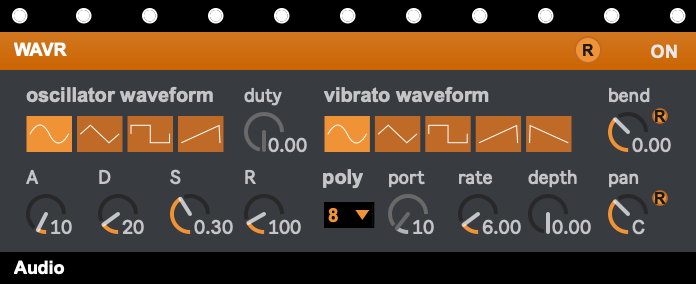
This is a basic wavetable synthesizer with the classic oscillator waveforms: sine, triangle, pulse, and sawtooth. The pulse and triangle waveforms have adjustable duty cycle.
A vibrato feature lets you use several waveform shapes to add low-frequency modulation to the main oscillator signal.
Set the amplitude envelope for a note using the attack, decay, sustain, and release (ADSR) dials.
Set the polyphony to the maximum number of simultaneous overlapping notes you think you will need, taking into account that long envelope release times tend to increase the number of simultaneous notes required. If you set the polyphony to 1, then you can adjust the portamento time, the time it takes to slide between consecutive notes.
This module produces stereo output, placing a mono signal into the stereo field according to the pan dial.
- FMODR

This is a simple FM synthesis instrument. You can think of the sound it makes as the result of extreme vibrato — vibrato made by a modulating oscillator (the modulator) affecting the frequency of the oscillator you listen to directly (the carrier). The frequency of the modulator is much higher than would be appropriate for creating vibrato; the result is the production of additional frequencies (sidebands) surrounding the carrier fundamental frequency. For classic FM synthesis, both the carrier and modulator should be sine waves. Using other waveforms makes the sound much more complex, even noisy in a metallic sort of way.
Increasing the index parameter (normally called modulation index) increases the brightness of the sound. Changing the harm parameter (harmonicity) changes the structure of the partial frequencies surrounding the fundamental. (The index must be greater than 1 for you to change harm.) Toggling the ‘i’ button lets you set harm to a floating point value, allowing the formation of enharmonic partials.
The vibrato, envelope, and portamento sections, as well as the pan knob, work exactly as they do for WAVR.
- NOISR
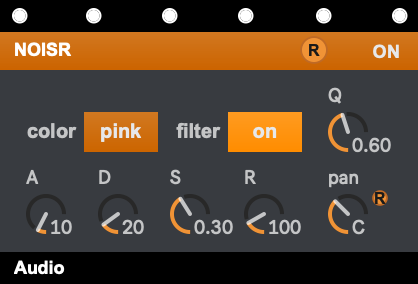
This module generates filtered noise notes using a band-pass filter applied to either white or pink noise. Higher values of Q create narrower bandwidths — narrow enough to result in sound that is close to a sine wave. The pitch of this note depends on the MIDI note number passed to the left inlet, as with the other synthesizer modules.
- STRUMR
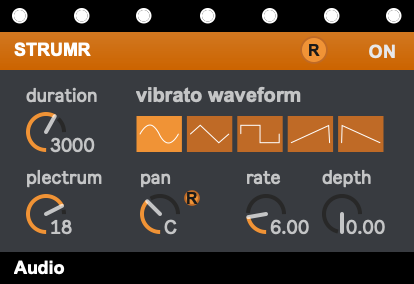
This is a Karplus-Strong plucked string model (or simulation) that produces fake harp, guitar, etc. sounds. These will never be mistaken for the real thing, but the sounds can work well through certain kinds of effects. The plectrum parameter models the rigidity of a guitar pick, with low values producing a darker sound and high values producing a brighter sound.
This synthesizer is not so happy with notes in extreme registers and may produce loud feedback-like sounds in response.
Sample Players
These modules play sound files. You drag a sound file into a rectangle within the module. It’s a good idea to copy a sound file into the folder that contains your patch before dragging it into a module.
- 1SHOTR

Trigger playback of a sound file, with adjustable start time within the file, duration, and a simple attack, release (AR) envelope. The release is controlled by the damp parameter. You can transpose the audio.
To trigger a note, send a MIDI velocity (1-127) to the left inlet.
- APLAYR
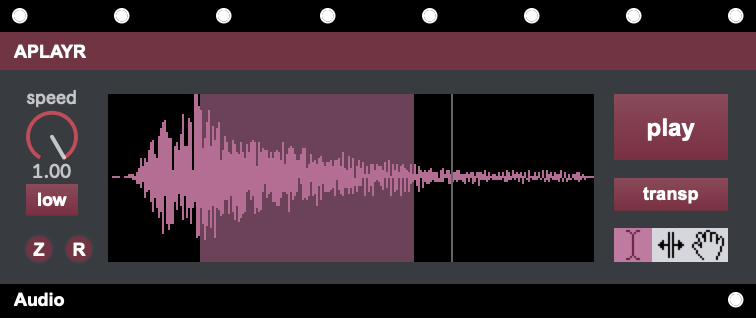
Play in a loop a selection of a sound file, with adjustable speed. By default, speed and transposition are linked, but pressing the transp button so that it’s no longer lit up lets the speed dial time-scale the audio with no transposition.
- GRANUL8R
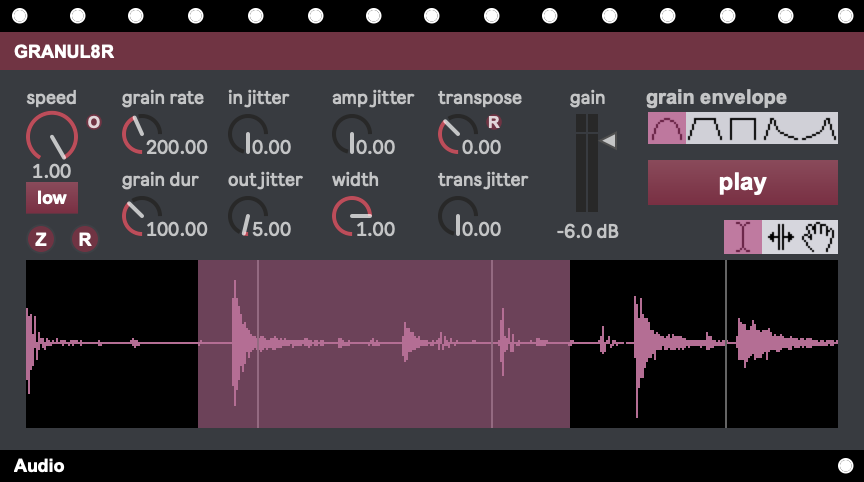
Granulate a sound file using a set of parameters common to many granulators. The playback cursor moves through the sound file in a loop, granulating the sound as it goes. The cursor can move at any speed, forwards or backwards. Press the low button to get a wider range for the speed dial. Grain rate controls how fast the grains are emitted. In jitter introduces random variation to the playback cursor, while out jitter randomizes the playback rate of grains. Trans jitter randomizes grain transposition.
- STRIKR
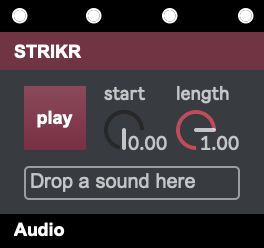
Play a mono sound file with almost no control over it, just the starting point within the file and its duration, as a proportion of the total file duration.
To trigger a note, send a MIDI velocity (1-127) to the left inlet.
(There actually are a number of messages you can send to the right inlet that will perform time-scaling and pitch-shifting of the audio.)
Effects
These effect modules accept an audio cable from any of the synthesizers and sample players, and they offer an audio cable to other effects or the OUT module.
These modules take stereo input and generate stereo output.
- 1DELAYR
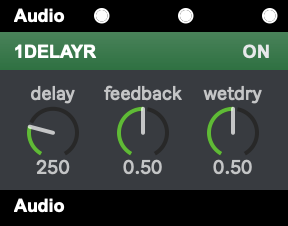
This is a simple delay unit with delay, feedback, and wet/dry controls. Changing the delay time does not produce a Doppler shift, as can happen with some other delays, such as 2DELAYR.
- 2DELAYR

This module runs the input into two parallel delays. Delay times for each are adjustable; there is a common feedback control. An optional filter appears in the feedback path between the output of the delay and its input. Freq is the cutoff frequency of this filter. If glide is greater than zero, changing the delay times can produce Doppler-shift glissando effects, with the length of glissando controlled by glide. When glide is zero, you will hear no Doppler shifts and should hear no clicks or glitches.
- BANKR
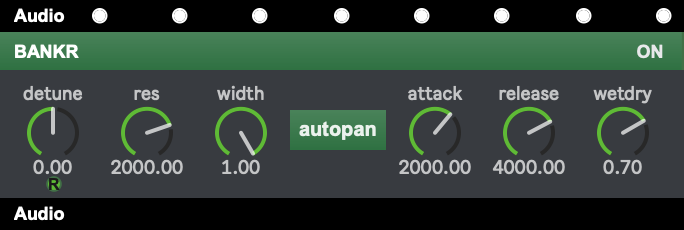
The input enters a bank of parallel bandpass filters with adjustable center frequency and resonance (or Q). Nothing happens unless you send a MIDI note to the module; then it will play that note, with the current attack and release times.
The pitch of the note sets the center of one bandpass filter. You can play as many as 32 simultaneous notes. Send a note as a list of MIDI note number and velocity, as with the synthesizer modules. Turn a note off with a velocity value of zero.
If autopan is on, BANKR randomly pans each note within the stereo field, whose width you adjust with the width dial. If autopan is off, each input channel runs straight through BANKR with no panning. Currently, BANKER accepts only stereo input and generates stereo output.
- COMBR

This module applies a recursive comb filter to the input, generating a buzzy series of harmonic partials. A lowpass filter with adjustable cutoff frequency lets you tame the buzziness.
- DRIVR
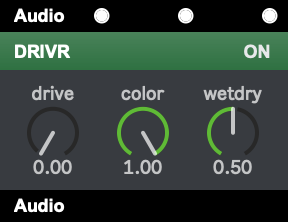
This is a simple overdrive distortion module.
- EQUALIZR
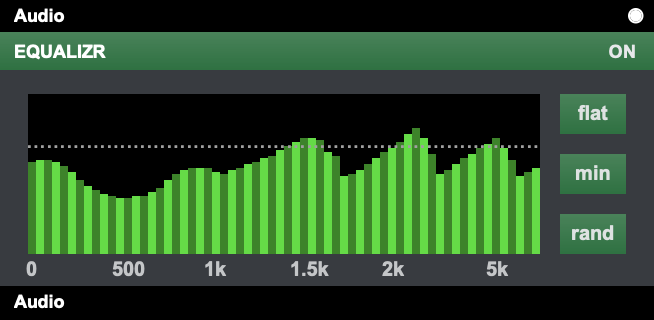
This is a 32-band graphic equalizer, implemented using an FFT. The sliders control the amplitudes of the bands. The rand button randomizes the amplitudes.
- GATR
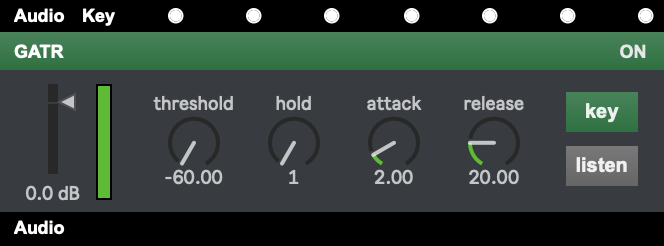
This module provides a gate dynamic processor with adjustable threshold and envelope controls. Hold determines the minimum amount of time the gate stays open once the input amplitude rises above the threshold.
The second audio inlet is for an optional key, or sidechain, input. Without this, the processor analyzes the signal sent to the left inlet and applies a gate to that same signal. Connect a key input, and the gate analyzes that signal, while applying its amplitude variations to a different signal entering the left inlet.
- REVERBER8R
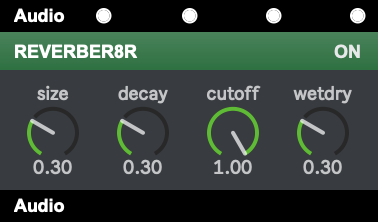
This reverberator features room size, decay time, lowpass filter cutoff frequency, and wet/dry mix controls.
- REZFILTR
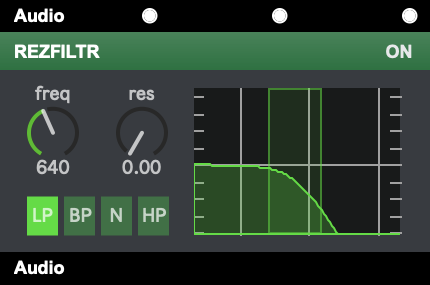
This is a simple resonant filter module with lowpass, bandpass, and highpass modes, with adjustable cutoff (or center) frequency and resonance.
- REZON8R
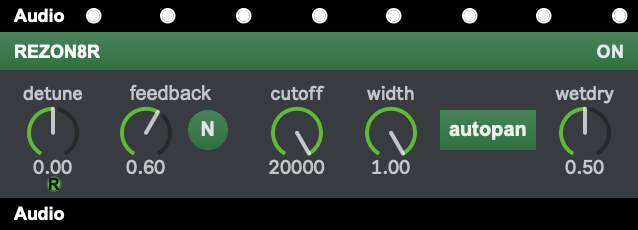
This module provides a bank of parallel comb resonators, with adjustable feedback and comb frequency. A lowpass filter helps mute some of the buzziness of the comb. Width controls the width of the stereo image, when autopan is on, exactly as with BANKR.
The pitch of a MIDI note sets the frequency of one comb filter. You can play as many as 32 simultaneous notes. Send a note as a list of MIDI note number and velocity, as with the synthesizer modules. This module ignores non-zero velocity values, treating them merely as a way to start a note. Turn a note off with a velocity value of zero.
- RINGR
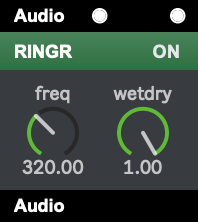
This is a ring modulator. For every sine wave component of the input, a ring modulator generates two other sine waves. The frequency of the upper sine wave is the sum of the input sine and the ring modulator frequency (freq). The frequency of the lower sine wave is the difference between the input sine and freq.
- SDELAYR

This module splits the input audio signal into 32 frequency bands. Each band has its own delay unit with feedback. The sliders adjust the delay times for the bands. The feedback dial controls feedback for all of the bands. Maxtime is the maximum delay time in seconds. The rand button randomizes the delay times.
The rotate dial shifts the list of 32 delay times to the right for use in the second audio channel. The times that fall off the right side of the list wrap around to the start of the list. This makes the two audio channels sound different, enhancing the stereo effect.
- TREMR
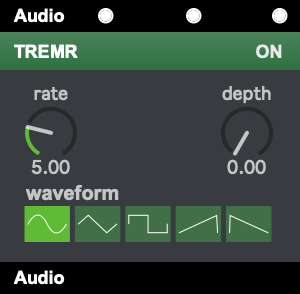
This module performs sub-audio rate amplitude modulation (or tremolo) on the input, with adjustable frequency and waveform shape.
Routing
These modules perform various audio routing or mixing tasks.
- CAPTR
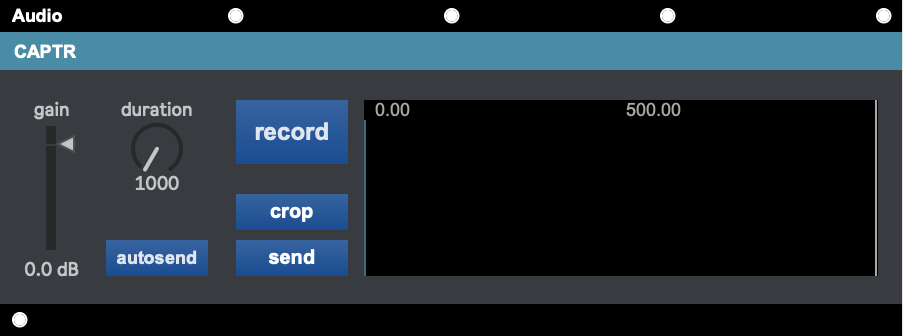
This module lets you record an audio signal into a buffer, to be passed on to the sampler modules. Connect the outlet of this module to the right inlet of the player modules.
To record, set the recording duration, and press record.
After recording, you can press the send button to send a reference to the recorded audio buffer to an appropriate playback module. Pressing autosend sends the reference whenever recording fills the waveform display.
The crop button extracts the selected audio, deleting any audio excluded from the selection.
- CROSSFADR
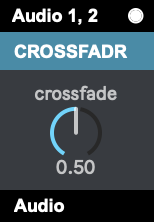
This lets you crossfade between two audio signals.
- IN

IN takes a stereo signal from outside of Max and makes it available to your patch, after running it through a fader and an optional high-pass filter.
By default, IN ignores the right-channel input and instead copies the left input into its right output channel. If you want to preserve stereo input, press the L > R button so that it reads stereo.
- MIXR
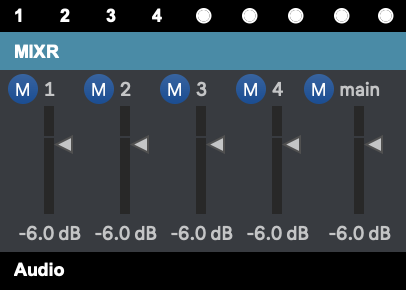
This mixer takes four inputs and mixes them to one output. The M fader controls the main output level. The M buttons let you mute channels and the main output.
- OUT

OUT sends your audio to the outside world, after passing it through a fader. The speaker button lets you turn on and off audio processing in Max.